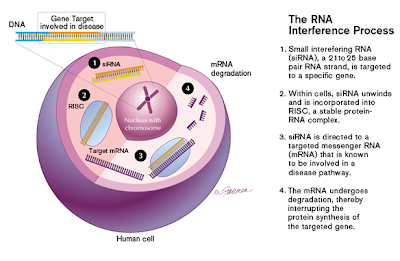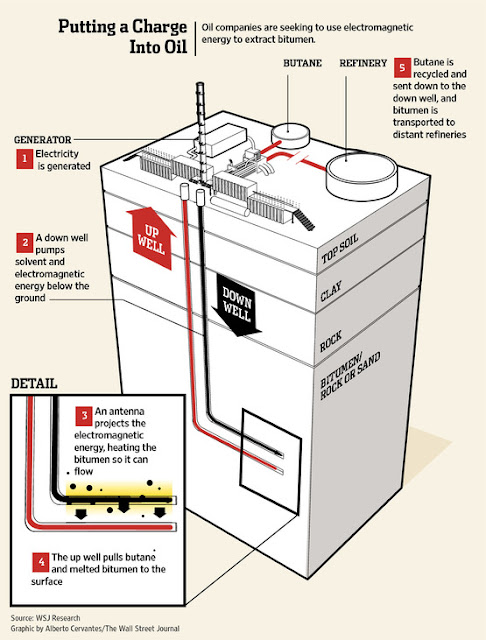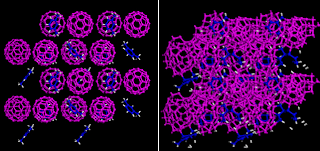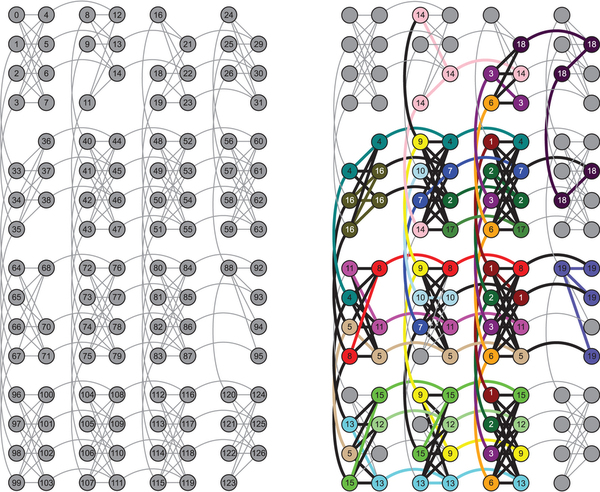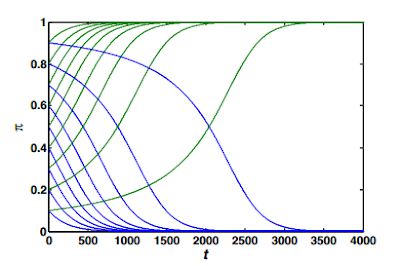Click here to read this mailing online.
|
Gene Control, Delivered Directly to the BrainTechnology Review - A biotech company called Alnylam announced today that a small clinical trial for a genetic therapy based on RNA interference, or RNAi, suggests that the technique can have a powerful effect on its target gene. The therapeutic effect lasted for over a month with just one dose. The company is also working with a medical device maker, Medtronic, on a way to deliver RNAi treatment directly to the brain, in order to treat the degenerative brain disease Huntington's.
The patients in the trial have a genetic disorder that originates in the liver and leads to the buildup of protein deposits in many organs. Alnylam, a Cambridge, Massachusetts-based company, says its RNAi therapeutic, given at its highest dose, reduces the amount of the faulty protein that spurs the disease by almost 94 percent. Read more » In Vivo Drug Factories to produce drugs in a specific spot and a specific timeThe Scientist - researchers use UV light to stimulate protein production in nano-sized delivery capsules in mice.
Science is one step closer to producing drugs in the right place at the right time in the body, avoiding the collateral damage of untargeted treatments. Researchers led by Daniel Anderson at the Massachusetts Institute of Technology have designed nanoparticles that can be stimulated via UV light to produce proteins on demand in vivo. Read more » Peter Thiel Invests in 3D Bioprinted Meat StartupCNET - Peter Thiel's philanthropic foundation gives up to $350,000 to a company named Modern Meadow, which plans to use 3D bioprinting to create an "edible prototype" that's a meat replacement.
Modern Meadow, is pitching bioprinted meat as a more environmentally-friendly way to satisfy a natural human craving for animal protein. Co-founder Andras Forgacs has sharply criticized the overall cost of traditional livestock practices, saying "if you look at the resource intensity of everything that goes into a hamburger, it is an environmental train wreck."
Modern Meadow prepared a summary of its work as part of a submission to the Department of Agriculture's small business grant program. Read more » Unlocking more of Canada's Oilsands While Emitting Less Pollution and Using Less Water1. Wall Street Journal - oil companies here are experimenting with technologies that could unlock even more reserves from what is some of the world's heaviest and stickiest petroleum. The new technologies could also drive down the cost of producing oil in Canada.
One consortium aims to get oil flowing to the surface by sending radio waves from huge antennae pushed through wells deep underground—adopting technology first developed for the U.S. government to eavesdrop on underground bunkers. Another company is working on inserting electrical heating coils into wells to melt the oil, while other firms are tinkering with petroleum-based solvents they hope to pump into wells to get more oil out. Read more » Superhard Diamond-Denting Material CreatedA superhard mixture of crushed carbon spheres and a hydrocarbon solvent is the world’s first hybrid crystalline/amorphous material. Its creation by an international scientific team that included Wendy Mao, a Stanford University professor and SLAC researcher.
The new material is one of a class that is hard enough to dent diamond, the hardest known material. The team created it by squeezing a mixture of soccer-ball-shaped carbon-60 molecules (popularly known as “buckyballs”) and a xylene solvent to extremely high pressures – up to 600,000 times atmospheric pressure – in a device called a diamond anvil cell. The cell holds a tiny amount of material that is pressed between the flattened tips of two opposing diamonds. Scientists can shine lasers or X-rays through the transparent diamonds to observe and identify any atomic-scale changes caused by the rising pressure. Carnegie Institution of Washington - The team discovered that there is a narrow window of pressure, about 320,000 times the normal atmosphere, under which this new structured carbon is created and does not bounce back to the cage structure when pressure is removed. This is crucial for finding practical applications for the new material going forward. The structure of carbon-60 solvate made with C-60 cages and m-xylene solvent. Science - Long-Range Ordered Carbon Clusters: A Crystalline Material with Amorphous Building Blocks Read more » Dwave Adiabatic Quantum Computer used by Harvard to solve Protein folding problemsA team of Harvard University researchers, led by Professor Alan Aspuru-Guzik, have used Dwave's adiabatic quantum computer to solve a protein folding problem. The researchers ran instances of a lattice protein folding model, known as the Miyazawa-Jernigan model, on a D-Wave OneTM quantum computer.
We present the first quantum-mechanical implementation of lattice protein models using a programmable quantum device. We were able to encode and to solve the global minima solution for a small tetrapeptide and hexapeptide chain under several experimental schemes involving 5 and 8 qubits for the four-amino-acid sequence (Hydrophobic-Polar model) and 5, 27, 28, and 81 qubits experiments for the six-amino-acid sequence under the Miyazawa-Jernigan model for general pairwise interactions. For the experiment with 8 qubits, we simulated the dynamics of the quantum device with a Redfield equation with no adjustable parameters, obtaining excellent agreement with experiment. Since the quantum annealing algorithm not only finds the ground state but also the low-lying excited states, it provides information about the relevant minimum energy compact structures of protein sequences and it is useful to evaluate designability and stability such as that found in natural protein sequences, where the global minimum of free energy is well separated in energy from other misfolded states. The approach employed here can be extended to treat other problems in biophysics and statistical mechanics such as molecular recognition, protein design, and sequence alignment. This was 81 qubit work. Dwave announced a 512 qubit chip was created late in 2011 and was being prepared for commercialization in 2012. The published research work generally lags the current work by 1-2 years. 512 qubits used for protein folding solutions would be a lot faster and should be able to solve far larger problems. Dwave should also be developing 2048 qubit chips in the next few years. Dwave recently landed the funding that will keep them going for another two years, which will hopefully take them to the point of financial profitability. At that point they would be able to IPO "The D-Wave computer found the ground-state conformation of six-amino acid lattice protein models. This is the first time a quantum device has been used to tackle optimization problems related to the natural sciences," said Professor Alán Aspuru-Guzik from the Department of Chemistry and Chemical Biology at Harvard University. Device architecture and qubit connectivity. The array of superconducting quantum bits is arranged in 4 × 4 unit cells that consist of 8 quantum bits each. Within a unit cell, each of the 4 qubits in the left-hand partition (LHP) connects to all 4 qubits in the right-hand partition (RHP), and vice versa. A qubit in the LHP (RHP) also connects to the corresponding qubit in the LHP (RHP) of the units cells above and below (to the left and right of) it. (a) Qubits are labeled from 0 to 127 and edges between qubits represent couplers with programmable coupling strengths. Grey qubits indicate the 115 usable qubits, while vacancies indicate qubits under calibration which were not used. The larger experiments (Experiments 1,2, and 4) were performed on this chip, while the three remaining smaller experiments were run on other chips with the same architecture. (b) Embedding and qubit connectivity for Experiment 4, coloring the 81 qubits used in the experiment. Nodes with the same color represent the same logical qubit from the original 19-qubit Ising-like Hamiltonian resulting from the energy function associated with Experiment 4 (see Supplementary material for details). This embedding aims to fulfill the arbitrary connectivity of the Ising expression and allows for the coupling of qubits that are not directly coupled in hardware. Nature Scientific Reports - Finding low-energy conformations of lattice protein models by quantum annealing. Read more » Prisoner Dilemma, which was used Cold War Politics Strategizing, has Winning SolutionsTechnology Review - The world of game theory is currently on fire. In May, Freeman Dyson at Princeton University and William Press at the University of Texas announced that they had discovered a previously unknown strategy for the game of prisoner's dilemma which guarantees one player a better outcome than the other.
That's a monumental surprise. Theorists have studied Prisoner's Dilemma for decades, using it as a model for the emergence of co-operation in nature. This work has had a profound impact on disciplines such as economics, evolutionary biology and, of course, game theory itself. Arxiv - Winning isn't everything: Evolutionary stability of Zero Determinant strategies (5 pages) Zero Determinant (ZD) strategies are a new class of probabilistic and conditional strategies that are able to unilaterally set the expected payoff of an opponent in iterated plays of the Prisoner's Dilemma irrespective of the opponent's strategy, or else to set the ratio be- tween a ZD player's and their opponent's expected payo ff. Here we show that while ZD strategies are weakly dominant, they are not evolutionarily stable and will instead evolve into less coercive strategies. We suggest that ZD strategies with an informational advantage over other players that allows them to recognize other ZD strategies will be evolutionarily stable (and able to exploit other players). However, such an advantage is bound to be short-lived as opposing strategies evolve to counteract the recognition. Read more » Scaling Mach Effect PropulsionTalk Polywell has a description of scaling Mach Effect (M-E) Propulsion from the current work by James Woodward.
M-E and the thrusts from M-E devices are 2 different things. The thrusts from the current UFG design (Woodward design) noted in this paper scale with the cube of frequency, and the frequency is limited only by the ionic limits of the material or "phase angle" that describes how quickly the ceramic can move. It is limited to the low Ghz region, so we're looking to start with an ability to scale up this thrust efficiency many orders magnitude. The current test article operates at 38kHz, so at least 5 orders magnitude frequency. The simplest reason for not building test items in the microwave region is that the electrical engineering for such power systems is really "black magic" indulged in by the best PhD EE's. Without a real staff with such people onboard, Ghz UFG's are not an option. Read more » Reinventing the toilet prize winnersAbout 2.5 billion people use unsafe toilets or defecate in the open. Poor sanitation causes severe diarrhea, which kills 1.5 million children each year. Smart investments in sanitation can reduce disease, increase family incomes, keep girls in school, help preserve the environment, and enhance human dignity.
In July 2011, the Bill and Melinda Gates Foundation announced an initiative to reinvent the toilet, along with $265 million in grants spread across a variety of efforts to spur greater innovation in sanitation. 
Read more » Miracle Economic Growth from Global Supply ChainsThe Economist magazine examines the question - Is the age of the growth miracle at an end?
Harvard economist Dani Rodrik, in which he argued that the age of the "growth miracle" was over. Industrialisation, long the engine of economic development, is becoming less able to support catch-up growth, he suggested, thanks to the falling labour-intensity of manufacturing, Chinese competition, and a rising mercantilist tide across the rich world. Michael Pettis agrees with Rofrik and thinks that growth miracles are investment booms and they end with misinvestment, debt and inflation. Richard Baldwin, whose research on a supply-chain-oriented view of globalisation and development was recently featured in the print edition, strongly disagrees: The truth is that globalization has been driven by advances in two very different types of "connective" technologies: transportation and transmission. Up till the late 1980s, globalization was mostly about lower trade and transportation costs. This "first unbundling" of production was associated with rising G7 shares of world income and trade... Read more » More Recent Articles |


